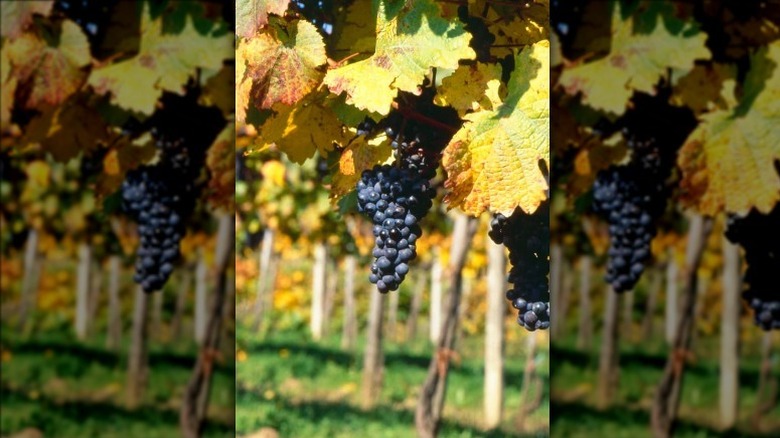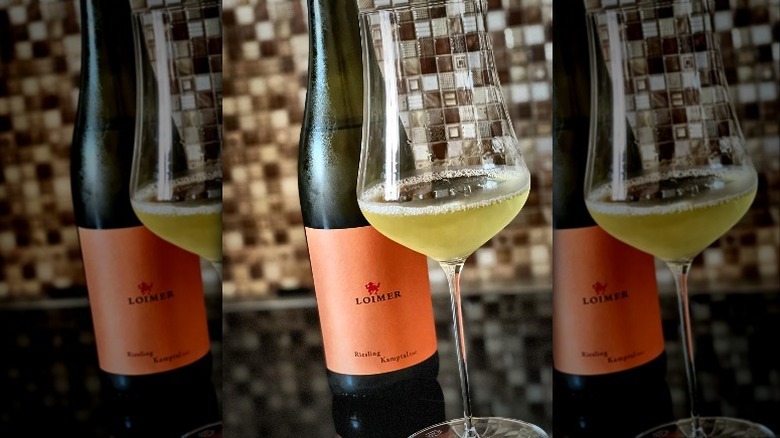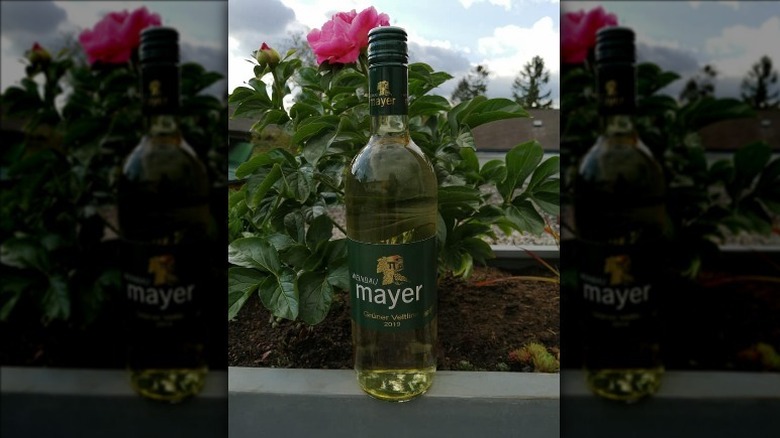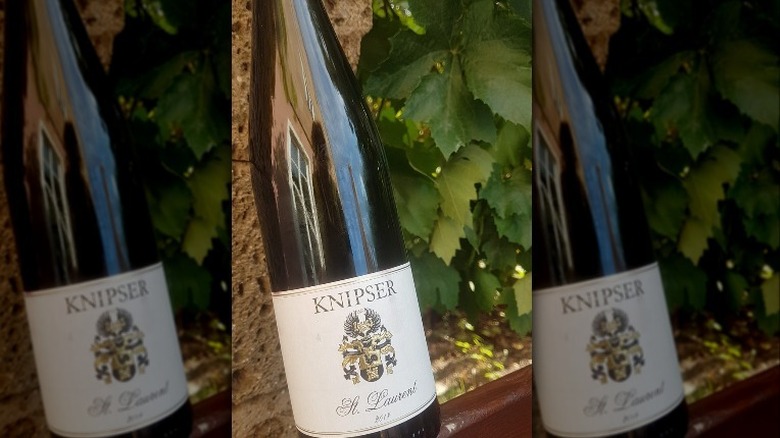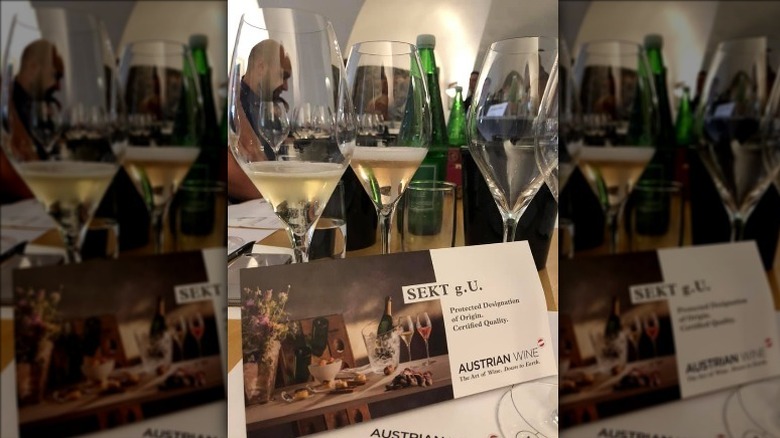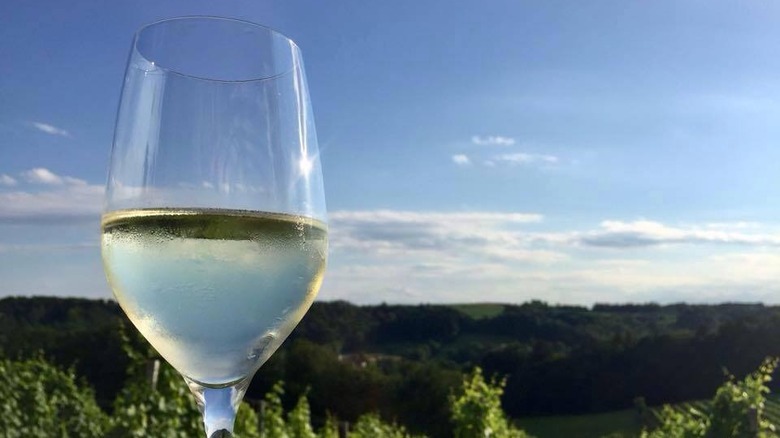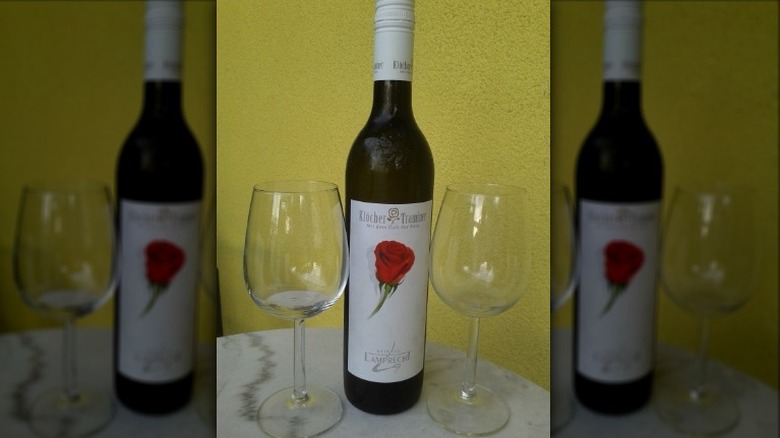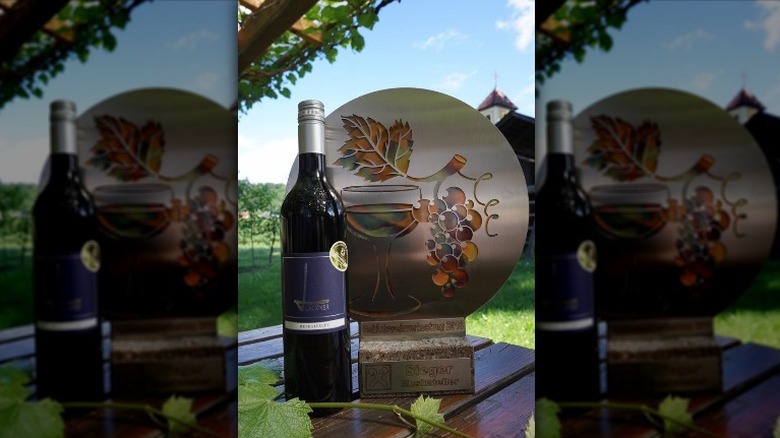Explore Austria With These 10 Wines
According to Statista, the majority of the wine produced in Europe comes from Italy, France, and Spain. But just because these countries are known for their high levels of production doesn't mean that's where your European wine journey should end. If you're looking for crisp white wines, tart, cherry-like reds, and refreshing wines made from grapes you've never heard of before, it's time to check out the wines of Austria. It's a country whose wine industry is gaining more and more recognition for its unique premium wines.
Austria borders Germany, which lies northwest of the country, so it makes sense that it grows some more-familiar grapes like riesling. However, the country also boasts some of its own varieties, many of which are gaining recognition in the global wine market. Let's take a closer look at some of Austria's most celebrated grapes and grape-growing regions. Whether you're planning to visit to check out the vineyards or you just want to better understand what you're sipping, this journey through Austrian wine country is guaranteed to be a good time.
Burgenland: Blaufränkisch
Among Austria's most celebrated black grapes is blaufränkisch. For all those who love Beaujolais and Gamay, blaufränkisch may just be your next favorite grape. The intensely rich black fruit is complemented by a striking acidity that makes this grape undeniably appealing to those who like refreshing reds. There are several areas around Austria where you can find vintners growing this grape, but according to Austrian Wine, it's most often found in central and southern Burgenland, which sits on the east side of the country.
It's possible to find blaufränkisch in a range of different styles. This wine's lighter, easy-drinking style can be enjoyed young and tends to be fresher and even chillable — perfect for drinking on a hot summer night. But the grape has range: It can also be used to produce oaked wines that, due to their high levels of tannin and acidity, have the potential to age for years. These oaked versions tend to be more concentrated and intense with greater structure.
Kamptal: Riesling
Before you skip this section because you've decided that riesling is too sweet for your taste, you should know that the majority of rieslings Austria produces are, in fact, dry. According to Austrian Wine, when you open a bottle of Austrian riesling, you're likely to encounter notes of peach and apricot. However, if you're drinking an Austrian riesling from Kamptal, located in Niederösterreich, you might also pick up on a mineral, flinty note that makes each sip that much more refreshing. Not all white wines can age well in the bottle, but if you find a quality Kamptal riesling, you can eventually expect it to develop floral notes of rose.
Riesling isn't the most widely planted grape in Austria (grüner veltliner takes that award, according to BK Wine Magazine), but it has established itself as one of the country's more interesting offerings. Whether you're already a diehard riesling lover or you just want to give it another try after a less-than-enjoyable sipping experience, Austrian riesling from Kamptal is a fantastic place to start.
Wien: Gruner Veltliner
Now, we'll take a look at perhaps the most famous Austrian variety of them all: grüner veltliner. If you like sauvignon blanc, there's a good chance you'll also be a fan of grüner. According to Wine Folly, wines made from this grape often display aromas of green pepper and lime, offering a refreshing zip of acidity that makes them super-drinkable. The majority of grüner you find on the market is going to be quite dry. Some of it will have small amounts of residual sugar, but considering the high acid level of these wines, it's difficult to pick up on that sweetness most of the time.
According to Austrian Wine, most grüner veltliner is planted in Niederösterreich and northern Burgenland, where the majority of the country's wine production takes place. However, you can still find some grüner veltliner in Wien, the area around the country's capital, Vienna.
Niederösterreich: Zweigelt
Do you love pinot noir? Are you a huge fan of Beaujolais nouveau? Have you tried a blaufränkisch in the past and fallen in love? If so, it's time to take a closer look at another one of Austria's most famous black grapes: zweigelt. According to Austrian Wine, zweigelt is a crossing between two other Austrian grapes: blaufränkisch and St. Laurent. Back in the day, it wasn't much of a celebrated grape. However, in the time between the second World War and the modern day, it's risen to prominence in Austria, and wine drinkers all over the world are trying to get a taste. This grape can be found all over the country, but over half of its plantings can be found in Niederösterreich (and Weinviertel) in particular.
According to Wine Folly, when you open a bottle of this wine, you're going to experience aromas of red cherry, raspberry, and black pepper. With a more intense expression of the grape, you may also encounter notes of chocolate and licorice. Its higher-than-average acidity ensures that you'll want to pour glass after glass, but the best examples offer a richness and complexity that let you know this is a wine to be taken seriously.
Thermenregion: St. Laurent
We've already covered zweigelt, but what about its parent grape, St. Laurent? Per Wine Folly, this is a grape that produces wines that are in some way similar to pinot noir, but St. Laurent tends to be more intense and more deeply colored. Notes of raspberry, blackberry and baking spices predominate, but you may also pick up on a rich chocolate-ly note as well.
According to Austrian Wine, St. Laurent got its name from the holiday St. Lawrence's Day, which takes place on August 10th every year. The grape earned this name because, historically, it began to go through veraison, which is the process that grapes go through when their color begins to change before harvesting.
This is another grape that it's possible to find in a variety of Austrian wine regions, but a large portion of its plantings can be found in Thermenregion, located in Niederösterreich.
Weinviertel: Sekt
One thing you should know about Austria is that it's a country that loves its sparkling wine. According to Wine Folly, Germany is the number one sparkling wine-drinking population in the world, but Austria comes in a close second. To meet that demand, Austria makes a lot of its own sparkling wine, which it calls sekt. In the past, sekt was known as a relatively inexpensive sparkling wine that didn't have much to offer serious wine drinkers. However, that image is changing, and some Austrian sekt is gaining a reputation for excellence.
These wines can be made with a wide range of grapes, from native grüner veltliner and blaufränkisch to international riesling and chardonnay. The most celebrated Austrian sekt is made in the traditional method (which is also the way Champagne is produced), with extended lees aging, which results in a wine with flavors of toast and bread dough. These examples tend to be dry, and they offer a bubbly experience that can easily go head-to-head with any of the great sparkling wines of the world. Many of these wines come from the Weinviertel region of Austria.
Steiermark: Welschriesling
If you've ever tried Croatian wine before, there's a chance you've encountered graševina. That same grape is planted in Austria, where it's referred to as welschriesling. This white grape produces white wines that tend to be relatively neutral (not dissimilar to a pinot grigio), according to Wine Folly. It also grows in nearby Hungary, where it's called olasz rizling, and in Slovenia, where it's referred to as laski riesling.
This grape is widely planted in Steiermark, per Austrian Wine, which boasts over a quarter of the grape's plantings in the country. The welschriesling from this area is relatively uncomplicated and is generally designed for easy drinking, although welschriesling from other parts of the country can be used for a wide variety of wine styles, including sparkling sekt and even sweet Trockenbeerenauslese wines.
However, it's not always an easy grape to find. Austrian Wine reports that in the past two decades, plantings of the grape have dwindled drastically, which may mean that it's not the easiest grape variety to find at your local wine shop.
Leithaberg: Neuburger
Nestled in the Austrian region of Burgenland sits Leithaberg, which accounts for a significant portion of the plantings of neuburger. Austrian Wine says that this grape generally produces full-bodied white wines that tend to taste floral and spicy when they're young but develop nutty qualities with age. And these are wines that can age — neuburger is known for making quality wines. So, why don't we see it that often at wine shops outside of Austria? There are a few reasons for that. Plantings of the grape have declined in recent years, largely because neuburger simply can't compete with the ubiquity of grüner veltliner. Additionally, it can be especially susceptible to disease and the negative effects of spring frost.
That doesn't mean that there are no grape growers producing this kind of wine anymore, though. While it might be hard to get your hands on, especially outside of Austria itself, neuburger is still an exciting native grape to check out if you love Austrian wines.
Südsteiermark: Traminer
Never heard of traminer before? You're not alone. But you may have heard of gewürztraminer before. Gewürztraminer is actually just one variety of traminer grape, the others being roter traminer and gelber traminer, according to Austrian Wine. It's also one of the parents of grüner veltliner. These wines have a lovely floral aromatic quality that makes them appealing for those who like intensely perfumed white wines. This grape often results in low yields but also a high sugar content, which can lead to a higher alcohol content as well. You're not going to get that racy acidity you often find in grüner veltliner, but rather, you may notice a lovely oily quality to the texture of the wine. Although they can be drunk young, high-quality traminers often have the ability to age for quite some time in the bottle, resulting in richer dried fruit flavors.
This is another grape that you'll find all over Austria, but one of the best places to look for it is in Südsteiermark, which is a part of the Steiermark region.
Weststeiermark: Gelber Muskateller
Here's another one that may seem unfamiliar at first glance: gelber muskateller. But in reality, you may have tried it before — it's the same thing as muscat blanc à petits grains (which is widely considered to be the best of the muscat grapes), and it's a grape that can produce a wide range of wine styles, per Austrian Wine. This type of wine certainly isn't new on the block to Austria or the rest of the world. Wine Searcher says that it's actually one of the oldest grapes in the world and that it originally came from ancient Greece. Wondering what it tastes like? Younger gelber muskateller can sometimes be too light and thin, but with a bit of age, wines made from this grape can really shine with floral aromas and an off-dry palate.
Wondering where to find it in Austria? Niederösterreich and Steiermark account for the majority of the plantings in the country, and Weststeiermark, located within Steiermark, produces some especially interesting expressions.

